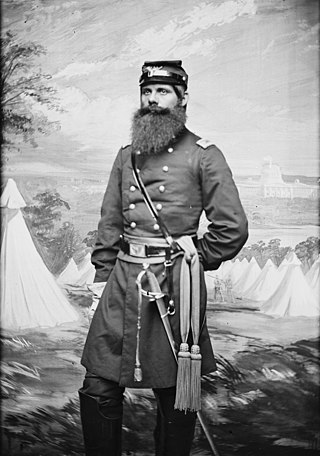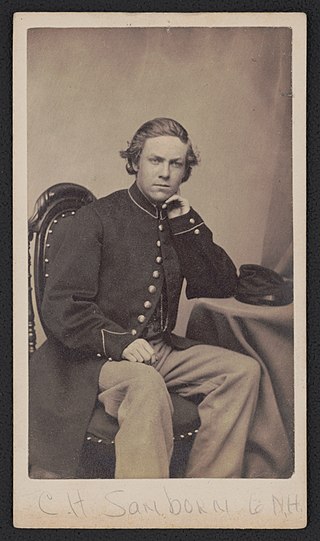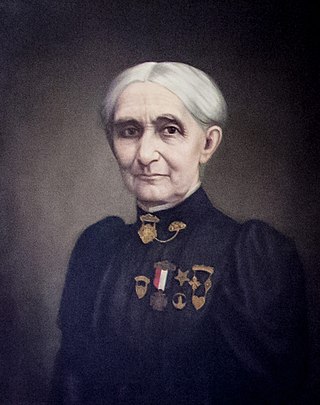See also
- List of New Hampshire Civil War Units
- Hartshorn Memorial Cannon (South Lyndeborough, New Hampshire)
| 2nd New Hampshire Infantry Regiment | |
|---|---|
| Active | 1861 - August 1864 |
| Country | United States of America |
| Allegiance | New Hampshire & Union |
| Type | volunteer infantry |
| Size | 1,013 |
| Engagements | Bull Run Williamsburg Fair Oaks Second Bull Run Malvern Hill Fredericksburg Gettysburg Cold Harbor |
| Commanders | |
| Notable commanders | Colonel Gilman Marston |
| New Hampshire U.S. Volunteer Infantry Regiments 1861-1865 | ||||
|
2nd New Hampshire Infantry Regiment was the longest-serving volunteer regiment of the State of New Hampshire in the American Civil War.
The 2nd New Hampshire was organized in early 1861 and mustered on June 4, 1861. The 2nd NH fought from First Bull Run until the occupation of Richmond approximately four years later. The regiment was led by Colonel Gilman Marston, a future United States congressman who represented the state in the 51st Congress (1889-1891).
The 2nd New Hampshire initially wore gray uniforms with "spiketail" dress coats trimmed in red cord, and "jaunty forage caps" with "2NH" on the crown.
Of the 900 who fought in the regiment's first battle at the First Bull Run, seven were killed, 56 wounded (seven mortally), and 46 missing (many of them wounded and all of them captured by Confederates). Marston had his arm shattered and refused amputation. He went on to recover and lead the 2nd New Hampshire at the battles of Williamsburg.
The 2nd New Hampshire is notable for being the only Union infantry regiment which made extensive use of the Gardiner exploding bullets, being issued these rounds in June 1863 for their Sharps rifles. These bullets were designed to explode one to three seconds after firing, and while primarily used to destroy wagons and other equipment they could have gruesome effect when used against other soldiers. Between July 1 and October 1 the regiment fired 4,000 Gardiner rounds in target practice and 10,000 in battle. [1]
At Gettysburg, the 2nd New Hampshire entered battle with 353 soldiers. In under three hours, 47 were killed, 136 wounded and 36 men went missing; of the 24 officers, only three were not killed or wounded. Due to their high losses, the 2nd New Hampshire was assigned to guard duty at Point Lookout, Maryland, with the 5th and 12th New Hampshire Volunteer Regiments. The 2nd New Hampshire returned to battle in time for the Battle of Cold Harbor where it suffered heavy casualties of nineteen killed and 54 wounded.
Shortly after Cold Harbor, 223 had completed their enlistments and returned home. Of the original members, 70 reenlisted and with recruits, continued to be the 2nd New Hampshire. However, many who returned home enlisted in other units. During the Civil War the regiment had 178 men killed or mortally wounded in action and another 172 deaths by disease, accidents, or as a result of being prisoners of war.
The 14th New Hampshire Infantry Regiment was an infantry regiment that participated in the American Civil War. It was the last three-year regiment raised in New Hampshire, serving from September 24, 1862, to July 8, 1865. Carroll Davidson Wright was one of its regimental leaders.
1st New Hampshire Infantry Regiment filled its ranks within two weeks of President Lincoln's call for 70,000 men on April 15, 1861. Between April 17 and 30, 1861, not less than 2,004 men volunteered to fight for the Union in the American Civil War. The volunteers organized and mustered at "Camp Union," the Fair Grounds of the Merrimack County Agricultural Society on the east side of the Merrimack River, in Concord between May 1 and May 7, 1861. After the 1st NH was filled, volunteers were given their choice to enlist in the 2nd New Hampshire Volunteer Regiment or serve their three months as the garrison of Fort Constitution at Portsmouth Harbor. Four hundred and ninety-six (496) enlisted in the 2nd NH, and the remainder were sent to Fort Constitution.
3rd New Hampshire Infantry Regiment was an infantry regiment in the Union Army during the American Civil War.

Gilman Marston was a United States representative, Senator, and United States Army general from New Hampshire.
The First New Jersey Brigade is the common name for an American Civil War brigade of New Jersey infantry regiments in the Union Army of the Potomac. Its official designation through most of its service was as the 1st Brigade, 1st Division, VI Corps.

The 2nd Wisconsin Infantry Regiment was an infantry regiment that served in the Union Army during the American Civil War. It spent most of the war as a member of the famous Iron Brigade of the Army of the Potomac. It suffered the largest number of casualties as a percentage of its total enlistment of any Union Army unit in the war.

The 6th Wisconsin Infantry Regiment was an infantry regiment that served in the Union Army during the American Civil War. It spent most of the war as a part of the famous Iron Brigade in the Army of the Potomac.
The 11th New Hampshire Infantry Regiment was a Union army infantry regiment that participated in the American Civil War. It was raised in the New England state of New Hampshire, serving from October 4, 1862, to June 4, 1865.

The 2nd Regiment Massachusetts Volunteer Infantry was an infantry regiment in the Union Army during the American Civil War. Major George H. Gordon, a West Point graduate and veteran of the Mexican–American War, organized the unit's recruitment and formation. The 2nd Massachusetts was trained at Camp Andrew in West Roxbury, Massachusetts on the site of the former Transcendentalist utopian community, Brook Farm. Roughly half the regiment was mustered in on May 18, 1861 and the remainder on May 25, 1861 for a term of three years. The regiment saw extensive combat as part of the Army of the Potomac particularly during the Battle of Antietam and the Battle of Gettysburg.
The 4th New Hampshire Infantry Regiment was an infantry regiment that served in the Union Army during the American Civil War.

The 5th New Hampshire Infantry Regiment was an infantry regiment that served in the Union Army during the American Civil War. The regiment sustained the greatest total combat losses of any infantry or cavalry regiment in the Union, with 295 killed and 756 wounded.

The 6th New Hampshire Infantry Regiment was an infantry regiment that served in the Union Army during the American Civil War.
The 9th New Hampshire Infantry Regiment was an infantry regiment that served in the Union Army during the American Civil War.
The 12th New Hampshire Infantry Regiment was an infantry regiment that served in the Union Army during the American Civil War. It was also a unit that existed for a time following the Revolutionary War.
The 13th New Hampshire Infantry Regiment was an infantry regiment that served in the Union Army during the American Civil War. This regiment had the distinction of having the first U.S. flags in the city of Richmond, Virginia, on April 3, 1865.
The 15th New Hampshire Infantry Regiment was an infantry regiment that served in the Union Army during the American Civil War.

Harriet Patience Dame was a prominent nurse in the American Civil War. Her portrait hangs in the New Hampshire State House.

The 48th New York Infantry Regiment was an infantry regiment in the Union Army during the American Civil War.
The 8th New Hampshire Infantry Regiment was an infantry regiment that served in the Union Army during the American Civil War.

The 100th Regiment Pennsylvania Volunteer Infantry was an infantry regiment that served in the Union Army during the American Civil War.